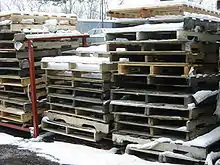Recycling by material
Recycling can be carried out on various materials
Asphalt
Asphalt concrete removed during road maintenance, resurfacing, and repair activities can be reclaimed and reused in new pavement mixtures, as an unbound aggregate base, or other civil engineering applications. Very little asphalt concrete — less than 1 percent, according to a survey by the Federal Highway Administration and the National Asphalt Pavement Association conducted annually since 2009 — is actually disposed of in landfills.[1] When asphalt pavement material is reclaimed for reuse, it is able to replace both virgin aggregates and virgin asphalt binder. Similarly, asphalt roof shingles can be recycled for use in new asphalt pavements.[2]
Concrete
Glass

Glass bottles and jars are gathered by a curbside collection truck and bottle banks, where the glass may be sorted into color categories. The collected glass cullet is taken to a glass recycling plant where it is monitored for purity and contaminants are removed. The cullet is crushed and added to a raw material mix in a melting furnace. It is then mechanically blown or molded into new jars or bottles. Glass cullet is also used in the construction industry for aggregate and glassphalt. Glassphalt is a road-laying material which comprises around 30% recycled glass. Glass can be recycled indefinitely as its structure does not deteriorate when reprocessed.
Metals
Aluminium
Aluminium is one of the most efficient and widely recycled materials.[3][4] Aluminium is shredded and ground into small pieces or crushed into bales. These pieces or bales are melted in an aluminium smelter to produce molten aluminium. By this stage, the recycled aluminium is indistinguishable from virgin aluminium and further processing is identical for both. This process does not produce any change in the metal, so aluminium can be recycled indefinitely.
Recycling aluminium saves 95% of the energy cost of processing new aluminium.[5] This is because the temperature necessary for melting recycled, nearly pure, aluminium is 600 °C, while to extract mined aluminium from its ore requires 900 °C. To reach this higher temperature, much more energy is needed, leading to the high environmental benefits of aluminium recycling. Americans throw away enough aluminium every year to rebuild their entire commercial air fleet. Also, the energy saved by recycling one aluminium can is enough to run a television for three hours.[6]
Copper
Like aluminium, copper is 100% recyclable without any loss of quality, regardless of whether it is in a raw state or contained in a manufactured product. In volume, copper is the third most recycled metal after iron and aluminium.
Iron and steel

Iron and steel are the world's most recycled materials, and among the easiest materials to reprocess, as they can be separated magnetically from the waste stream. Recycling is via a steelworks: scrap is either remelted in an electric arc furnace (90-100% scrap), or used as part of the charge in a Basic Oxygen Furnace (around 25% scrap).[7] Any grade of steel can be recycled to top quality new metal, with no 'downgrading' from prime to lower quality materials as steel is recycled repeatedly. 42% of crude steel produced is recycled material.[8]
Other metals
For information about recycling other, less common metals, refer to:
Plastic
The vast majority of plastic is non-biodegradable, so recycling is a part of global efforts to reduce plastic in the waste stream. There are many types of plastic and they generally have to be separated by type for successful recycling. The low density of plastics increases transportation costs per unit weight.
Timber

Recycling timber has become popular due to its image as an environmentally friendly product, with consumers commonly believing that by purchasing recycled wood the demand for green timber will fall and ultimately benefit the environment. Greenpeace also view recycled timber as an environmentally friendly product, citing it as the most preferable timber source on their website. The arrival of recycled timber as a construction product has been important in both raising industry and consumer awareness towards deforestation and promoting timber mills to adopt more environmentally friendly practices.
References
| Wikimedia Commons has media related to Recycling by material. |
- Williams, Brett A.; Willis, J. Richard; Ross, T. Carter (17 September 2019). IS 138: Asphalt Pavement Industry Survey on Recycled Materials and Warm-Mix Asphalt Usage — 2018 (PDF). Greenbelt, Maryland: National Asphalt Pavement Association. Archived (PDF) from the original on 2019-09-18. Retrieved 2019-07-18.
- "Economics and Markets for Recycling Asphalt Shingles". ShingleRecycling.org. Construction & Demolition Recycling Association. Retrieved January 14, 2020.
- DRLP Fact Sheets
- Environmental Protection Agency Frequently Asked Questions about Recycling and Waste Management
- "The price of virtue". The Economist. June 7, 2007.
- "Recycling metals - aluminium and steel". Archived from the original on 2007-10-16. Retrieved 2007-11-01.
- "Sustainable Development and Steel, Canadian Institute of Steel Construction". Retrieved 2006-11-16.
- "Sustainable indicators 2014.pdf - World Steel Association" (PDF). Retrieved 2015-01-06.
